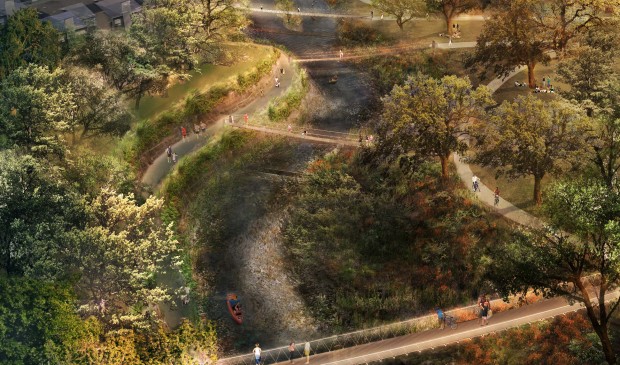Waller Creek parks system now called Waterloo Greenway
Thursday, August 22, 2019 by
Chad Swiatecki The $250 million system of parks planned for areas surrounding Waller Creek in downtown Austin will be known as the Waterloo Greenway going forward, following a naming ceremony held Wednesday at the headquarters of the conservancy in charge of developing the park system.
The name comes after roughly a year of planning to brand the ambitious project, which sits in close proximity to the Austin Convention Center, Red River Cultural District, the Dell Medical School and Palm Park, all of which are undergoing changes expected to remake the face of downtown Austin over the next decade-plus.
Peter Mullan, CEO of the rebranded Waterloo Greenway Conservancy, said long-term planning for the park system accelerated last summer after City Council approved extending the duration of the tax increment reinvestment zone created initially to capture funds for the Waller Creek Tunnel that was created to prevent flooding concerns in large portions of the creek area. The extension is projected to generate $110 million for the park system, with the balance of the money coming from fundraising efforts.
To date, the conservancy has raised $50 million from private giving, including 18 gifts of more than $500,000.
“When the city amended the TIRZ we had more certainty about moving forward with the project itself and that enabled us to look a little more broadly at everything that was happening around us,” Mullan said. “That’s something that’s important, because we’re not operating in a vacuum and there’s a large ecosystem with incredible assets in this district. All these things have been percolating, we are now realizing we all have the opportunity to become a reality.”
A reconstruction of Waterloo Park is expected to open next fall and will be the first significant improvement made to property along the creek area. Construction on a second phase known as Creek Delta includes redesigned parkland south of Cesar Chavez Street and trail improvements and creek restoration from Lady Bird Lake to Fourth Street.
All phases are expected to open by 2026.
Mayor Steve Adler said the park system has had consistent support from Council and residents and dodged the controversy that has dogged related capital projects like the cost overruns on the tunnel and the proposed expansion of the convention center.
“The greenway here has always had lots of support. Certainly there have been lots of conversations on the pieces all around it between the tunnel, the convention center and the innovation zone, and all of those have had significant consternation around them,” he said. “But the Waller Creek project is our Central Park and has always had incredible support because people realize how valuable that is.”
The widespread changes to the area, which includes one of Austin’s most significant concentrations of live music venues, have caused worries from some cultural onlookers because of the likelihood that the parks and other development will push property values higher for small-margined businesses.
The city’s creation of the Red River Cultural District was a step to help those businesses band together to help shape the changes and attract new customers drawn to the area.
“When faced with change and uncertainty one can see everything as a threat – which certainly exemplifies the music community’s views of Red River 10, 15, 20 years ago – or you can see it as an opportunity,” said Cody Cowan, executive director of the Red River Merchants Association.
“Keeping Red River crummy isn’t how economics works and change was coming in spite of us, and now we’re taking the other perspective that all the small businesses there have lots of opportunity to determine what the future holds for Red River.”
Mullan said there will likely be some further planning action and perhaps a regulating plan from City Council in the near future, but he’s waiting to see what’s included in the finished rewrite of the city’s land use code before drafting any planning documents.
Another near-term concern is the debate over the future of the Palm School, with leaders from the city and Travis County expressing divergent plans for the site in recent months.
“Palm School is something of a question mark and a crucible, and it would be great if the city and the county can come to some kind of common ground in how that fits into the larger planning agenda,” he said. “The importance of that site has become only more clear. It’s the hinge and a gateway to downtown and the link to Rainey Street, so connecting (the system) to Palm Park is a big goal.”
Image courtesy of Michael Van Valkenburgh Associates/Waller Creek Conservancy.
The Austin Monitor’s work is made possible by donations from the community. Though our reporting covers donors from time to time, we are careful to keep business and editorial efforts separate while maintaining transparency. A complete list of donors is available here, and our code of ethics is explained here.
You're a community leader
And we’re honored you look to us for serious, in-depth news. You know a strong community needs local and dedicated watchdog reporting. We’re here for you and that won’t change. Now will you take the powerful next step and support our nonprofit news organization?










